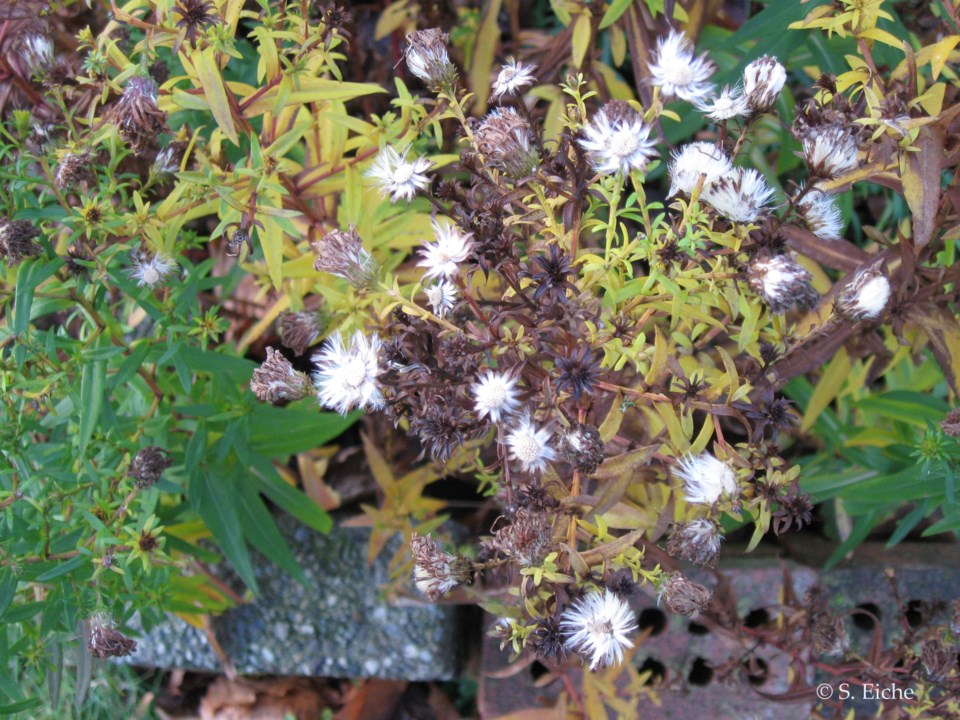In the spring and summer we need strong arms and legs and a strong back to bring the garden into the world, to nurture it and protect it from harm. The life of our plants runs on a cycle that is fine-tuned by the weather. Deep into the summer most of our plants are moving towards the last stages of that cycle, which they’ll reach in late autumn or winter.
However, the very last stage continues to be full of the kind of life that’s vital to nature. We haven’t always regarded winter that way. We used to consider it the time to rush whatever remained of the vegetation to a brutal, final finish. With those same strong arms, legs and back that ushered in the garden a few months earlier, we wiped the garden clean in winter. An arrogant conviction that we were in charge of nature persuaded us to remove everything that disturbed our (unnatural) picture of what a garden should look like – neat and tidy.
For some time now, ecologists, biologists, zoologists and others have been urging us to hold back interfering in the natural processes of the environment. They’ve been encouraging us to embrace biodiversity and practice conservation. I admit that a dozen or so years ago I would have been putting the garden “to bed” in the winter – but then I started paying close attention to the behaviour of the birds and other wildlife. When I watched where they went and what they were doing, I realized that for them the garden was still a food source and full of hiding places. How could I wrest all this from them?
A local store selling bird seed has an ad on the radio that makes it sound as if the food you buy from them is all you’ll need to attract a host of birds to your yard. Putting out seed and suet is certainly good, especially when the ground is frozen or under snow, but the birds will flock to your yard all the same if you have lots of leaves on the ground, lots of plants gone to seed and stems with dried flowerheads, lots of bushes with closely intertwined branches where they can perch, and some evergreen trees, small or large, with foliage that offers safe refuge when a predator, such as a cat, is on the prowl.
In my garden the dried seeds and flowerheads that the sparrows, finches and juncos especially like are the asters (all varieties), bee balm, Greek oregano, parsley and fennel. I’ve also watched the bushtits, twenty-strong, descend on the Greek oregano stems and peck at the seeds, even though suet is usually their food of choice.
When my parents bought this house in 1968, they planted several trees. A couple of them have had to come down because they’d been topped (before there was a bylaw against topping) and were rotting. But the linden, beech, rowan and hawthorn survive. When they drop their leaves, I rake only those that have fallen on the lawn and toss them over garden beds. The birds know that they hide a bounty of nourishing worms and insects.
The leaves that drop around the trees themselves look like flared circle skirts laid at their base. Over the years, birds sitting in the branches of the linden tree have dropped rowan and hawthorn berries, so now the linden tree has acquired a little orphanage of rowan and hawthorn saplings growing out of the leaf skirt. The sapling orphans share the space with the primroses that I’ve transplanted under the tree, year after year, when the potted spring primroses fade and die. Chickadees like to eat the primrose flowers, almost as much as they like to eat the crocus flowers in the spring. Who am I to deny them that pleasure?
I’ve learned that everything in the garden plays a role and that nature’s program is meticulous. I don’t see any reason to fiddle with the dial and change the settings.
Sabine Eiche is a local writer and art historian with a PhD from Princeton University. She is passionately involved in preserving the environment and protecting nature. Her columns deal with a broad range of topics and often include the history (etymology) of words in order to shed extra light on the subject



